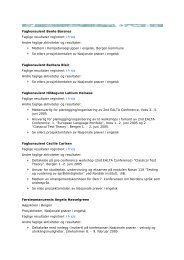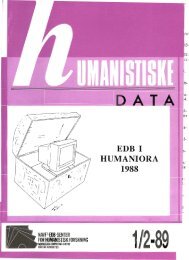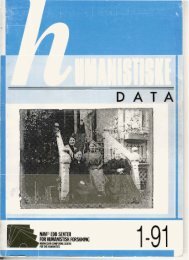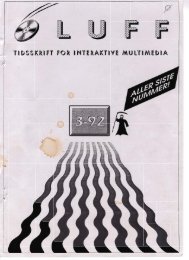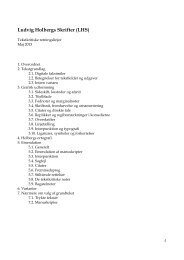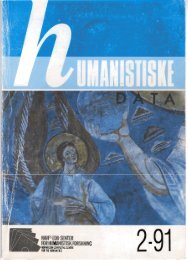Measuring corpus homogeneity using a range of measures for inter ...
Measuring corpus homogeneity using a range of measures for inter ...
Measuring corpus homogeneity using a range of measures for inter ...
Create successful ePaper yourself
Turn your PDF publications into a flip-book with our unique Google optimized e-Paper software.
ecordings, spontaneous natural conversations), and written<br />
English into nine (e.g., applied science, arts, belief and<br />
thought). There are 24 genres <strong>for</strong> spoken and 46 genres <strong>for</strong><br />
written English (among the genres <strong>for</strong> written English there<br />
are <strong>for</strong> example personal letters, university essays, tabloid<br />
newspaper, bibliographies and instructional texts).<br />
To avoid comparing classes whose size is too dissimilar:<br />
¡<br />
¡<br />
each BNC document is divided into chunks <strong>of</strong> a fixed<br />
size. For the first experiment, chunks <strong>of</strong> 20,000 words<br />
were produced. If a document is too small it is discharged.<br />
If it is big enough to contain more than one<br />
chunk, multiple chunks are produced, and considered<br />
as individual documents in the analysis;<br />
<strong>for</strong> each BNC classes from medium, domain and<br />
genre, a <strong>corpus</strong> is created with the same number <strong>of</strong><br />
chunks. For the experiment we produced corpora <strong>of</strong><br />
20 chunks each. If a class does not contains enough<br />
documents it is discharged; otherwise 20 chunks are<br />
chosen randomly.<br />
This gives 51 corpora with 20 documents <strong>of</strong> 20,000<br />
words each. Three random corpora made <strong>of</strong> 20 chunks chosen<br />
randomly from the BNC are also created. We expected<br />
random corpora to be less homogeneous than all the other<br />
corpora.<br />
The three <strong>homogeneity</strong> <strong>measures</strong> (<strong>using</strong> � § �¨� � � � , � �<br />
and ��� ) <strong>for</strong> each <strong>corpus</strong> are calculated, and the corpora are<br />
ranked according to their <strong>homogeneity</strong> score: corpora with<br />
a lower score are considered more homogeneous than ones<br />
with a higher score. Then the 54 corpora are merged to<br />
<strong>for</strong>m one big <strong>corpus</strong>, and Rainbow is used to see how accurately<br />
it can recover each <strong>of</strong> the 54 corpora, <strong>using</strong> training<br />
sets <strong>of</strong> different sizes. The sizes used were 1, 5, 10, 15; e.g.,<br />
when the training set size was 5, the task <strong>for</strong> Rainbow was<br />
to recover the other 15 same-class documents out <strong>of</strong> the pot<br />
<strong>of</strong> 1080 documents. For each <strong>corpus</strong>, we compute the accuracy,<br />
the proportion <strong>of</strong> correctly classified documents, and<br />
the standard deviation calculated on 50 trials.<br />
6. Results<br />
Tables 2 and 3 list the <strong>homogeneity</strong> <strong>measures</strong> <strong>for</strong> the<br />
five corpora at the beginning and end <strong>of</strong> the lists ranked by<br />
<strong>homogeneity</strong> and Rainbow accuracy values, <strong>using</strong> all words<br />
as features. Using Rainbow, the three random corpora appear<br />
to be less homogeneous than all the other corpora,<br />
as expected. The <strong>homogeneity</strong> <strong>measures</strong> based on <strong>inter</strong>document<br />
distance instead partially failed; in fact, although<br />
they all appear somewhere at the bottom <strong>of</strong> the rank list,<br />
just one <strong>of</strong> them turns up after all the non-random corpora.<br />
We use Spearman’s rho test (Owen and Jones, 1977) to<br />
compare the ranks obtained <strong>using</strong> the <strong>homogeneity</strong> measure<br />
and Rainbow. Spearman’s correlation is when the two<br />
ranks are exacly the same, and � when no correlation is<br />
found between the two ranked lists. The results, presented<br />
in table 4 <strong>for</strong> all words and in table 5 <strong>for</strong> content words, are<br />
always positive and usually within the significance level <strong>of</strong><br />
¡£¢<br />
.<br />
� § �¨� � � � ��� ���<br />
Corpus<br />
g-W news script 0.0489 0.0304 0.0663<br />
g-W newsp tabloid 0.0948 0.0640 0.1503<br />
g-W newsp other report 0.1208 0.0817 0.1951<br />
g-W newsp other sports 0.1335 0.0750 0.1756<br />
g-W hansard 0.1459 0.0950 0.2283<br />
d-W app science 0.6165 0.2973 0.7737<br />
m-m unpub 0.6502 0.3711 0.9649<br />
g-W misc 0.6572 0.2818 0.7040<br />
g-W advert 0.7201 0.2949 0.7519<br />
random2 0.94344 0.4200 1.0906<br />
Table 2: Homogeneity scores computed <strong>using</strong> the 500 most<br />
frequent words in each <strong>corpus</strong><br />
Rainbow Homogeneity Spearman’s<br />
correlation<br />
1 doc per class � § �¨� � � � 0.526<br />
1 doc per class �¨� 0.527<br />
1 doc per class ��� 0.530<br />
5 doc per class � § �¨� � � � 0.447<br />
5 doc per class �¨� 0.473<br />
5 doc per class ��� 0.474<br />
10 doc per class � § �¨� � � � 0.432<br />
10 doc per class �¨� 0.451<br />
10 doc per class ��� 0.451<br />
15 doc per class � § �¨� � � � 0.387<br />
15 doc per class �¨� 0.413<br />
15 doc per class � � 0.415<br />
Table 4: Spearman’s correlation between Rainbow accuracy<br />
values and Homogeneity values <strong>using</strong> words<br />
7. Conclusion and future work<br />
The Spearman correlation values show that the original<br />
distinction between homogeneous and heterogeneous corpora<br />
is maintained in Rainbow: corpora with a low <strong>homogeneity</strong><br />
score need a small training set to achieve a high accuracy<br />
in the classification task. By contrast, heterogeneous<br />
and random corpora need a bigger training set to achieve an<br />
accuracy which, however, is smaller than the one obtained<br />
by the homogeneous corpora.<br />
None <strong>of</strong> the three text-similarity <strong>measures</strong> used to compute<br />
<strong>homogeneity</strong> produces a rank which follows exactly<br />
the same order identified with Rainbow, even if the constant<br />
high values <strong>of</strong> the standard deviation suggest that the rank<br />
order identify by Rainbow is not fixed. Among the three<br />
<strong>measures</strong>, ��� provides the closest rank, expecially when<br />
all words are used.<br />
Various reasons may be responsible <strong>for</strong> the unclarity <strong>of</strong><br />
the results:<br />
¡<br />
lack <strong>of</strong> data: chunks, in which we divide the documents,<br />
and the number <strong>of</strong> chunks, we set <strong>for</strong> each <strong>corpus</strong>,<br />
are not big enough. For this experiment we produce<br />
chunks <strong>of</strong> 20,000 words and we use corpora <strong>of</strong><br />
20 chunks each. We also try to use chunks <strong>of</strong> 50,000<br />
words and corpora made <strong>of</strong> 50 chunks each, but the




